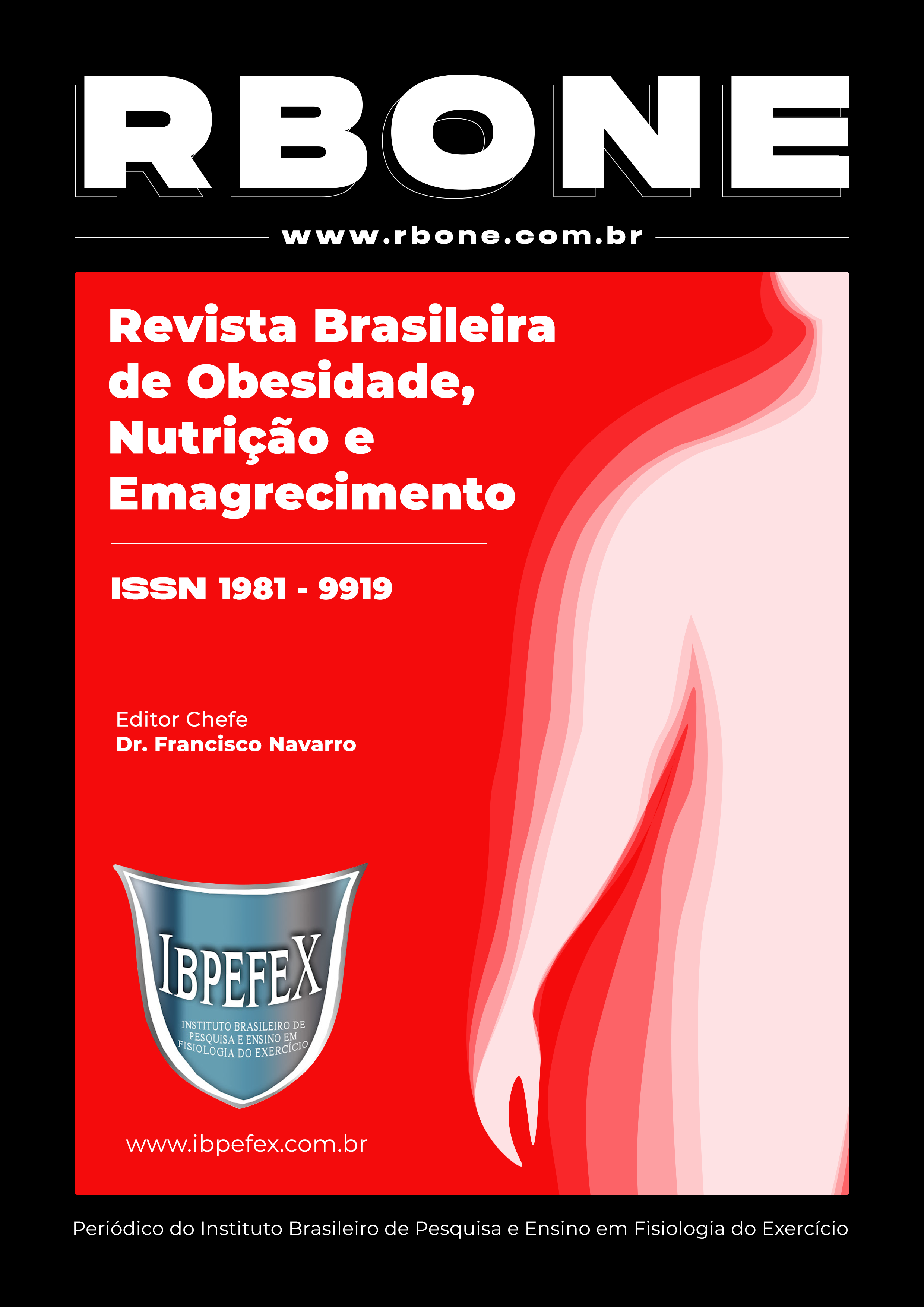Plantar profile of obese individuals and its association with pain in the feet
Abstract
Introduction: Obesity is associated with health complications, overloads on the lower limb segments, whic can alter the configuration of the plantar arch and cause problems such as pai in the foot. Objective: To analyze the relationship betweem the plantar arch and the occurrence of foot pain in obese womem. Material and methods: This is a cross-sectional study of 132 obese adult women, aged between 20 and 60 years. They were evaluated for BMI, intensity of foot pain, plantigraphy and Foot Function Index - Brazil (FFI). Results: The presence of flat arches was related to the high body mass index, as well as the pain referring to the questionnaire Foot Function Index (FFI). Was found a prevalence of 41.9% cavus foot, 39.3% typical and 18.9% flat. When the foot was related to anthropometric measurements, the flat plantar arch was more prevalent among those with higher anthropometric measurements. Conclusion: In this study with obese women, it was found that the largest anthropometric measurements are related to the presence of a flat plantar arch and the presence of pain in this region, including pain related to the daily situations of obese women. The movement professionals' view of these patients is extremely important for the education, prevention and treatment of the obese population, in order to avoid overweight.
References
-Baker, E. H. Overweight and Obesity: Prevention and Weight Management. International Encyclopedia of Public Health. 2017. p. 383-389.
-Butterworth, P.A. The association between obesity and foot pain: metabolic, biomechanical or both?. Journal of Foot and Ankle Research. Vol. 8. 2015.
-Chougala, A. e colaboradores. Screening of bodymass index and functional flatfoot in adult: an observational study. International Journal of Physiotherapy and Research. Vol. 3. Num. 3. 2015. p. 1037-1041.
-Cieślińska-Swider, J.; Furmanek, M. P.; Blaszczyk, J. w. The influence of adipose tissue location on postural control. Journal of Biomechanics. Vol. 60. 2017. p. 162-169.
-Dufour, A.B. Obesity, foot pain and foot disorders in older men and women. Obesity Research and Clinical Practice. 2017.
-Eggers, B. S. S. Obesity Prevalence and Health Consequences: Findings From the Survey of the Health of Wisconsin, 2008-2013. Wisconsin Medical Society. Vol. 115. Num. 5. 2016. p. 238-244.
-Filoni, E.; e colaboradores. Comparação entre índices do arco plantar. Motriz. Vol. 15. Num. 4. 2009. p. 850-860.
-Hills, A. P.; e colaboradores. The biomechanics os adiposity- structural and functional limitations of obesity and implications for movement. Obesity Reviews. Vol. 3. Num. 1. 2012. p. 35-43.
-Jankowicz-Szymanska, A.; e colaboradores. Foot longitudinal arches in obese, overweight and normal weight females who differ in age. Journal of Comparative Human Biology. Vol. 69. 2018. p. 37-42.
-Kirby, K. A. Longitudinal arch load-sharing system of the foot. Revista Espoñola de Podología. Vol. 28. Num. 1. 2017. p. 18-26.
-Latey, P. J. Relationship between foot pain, muscle strength and size: a systematic review. Physiotherapy. Vol. 103. Num. 1. 2017. p. 13-20.
-Levinger, P. A comparison of foot kinematics in people with normal- and flat-arched feet using the Oxford Foot Model. Gait & Posture. Num. 32. 2010. p. 519-523.
-Menz, H. B. Chronic foot pain in older people. Maturitas. Vol. 91. p.110-114. 2016.
-Melo, I. T.; São-Pedro, M. Dor musculoesquelética em membros inferiores de pacientes obesos antes e depois da cirurgia bariátrica. ABCD Arquivo Brasileiro de Cirurgia Digestiva. Vol. 25. Num. 1. 2012. p. 29-32.
-Mickle, K. J.; Steele, J.R. Obese Older Adults Suffer Foot Pain and Foot-Related Functional Limitation. Gait & Posture. Vol. 42. Num. 4. 2015. p. 442-447.
-Mueller, S. Influence of Obesity on Foot Loading Characteristics in Gait for Children Aged 1 to 12 Years. PLOS One. Vol. 11. Num. 2. 2016. p. e0149924.
-Price, C.; Nester, C. Foot dimensions and morphology in healthy weight, overweight and obese males. Clinical Biomechanics. Vol. 37. 2016. p. 125-130.
-Sullivan, J.; Bruns, J.; Adams, R.; Pappas, E.; Crosbie, J. Plantar heel pain and foot loading during normal walking. Gait & Posture. Vol. 42. 2015. p.688-693.
-Wannmachar, L. Obesidade como fator de risco para morbidade e mortalidade: evidências sobre o manejo com medidas não medicamentosas. OPAS/OMS. Representação Brasil. Brasília. Vol. 1. Num. 7. 2016. p. 1-10.
-Yi, L. C. Influência do índice de massa corporal no equilíbrio e na configuração plantar em obesos adulto. Revista Brasileira de Medina do Esporte. São Paulo. Vol. 20. Num. 1. 2014. p. 70-73.
-Yi, L. C. Tradução e adaptação cultural do Foot Function Index para a língua portuguesa: FFI - Brasil. Revista Brasileira de Reumatologia. Vol. 55. Num. 5. 2015. p. 398-405.
Copyright (c) 2023 Jerônimo Costa Branco, Maria Augusta Barcellos Cabral, Sheila Sporh Nedel

This work is licensed under a Creative Commons Attribution-NonCommercial 4.0 International License.
Authors who publish in this journal agree to the following terms:
- Authors retain the copyright and grant the journal the right of first publication, with work simultaneously licensed under the Creative Commons Attribution License BY-NC which allows the sharing of the work with acknowledgment of the authorship of the work and initial publication in this journal.
- Authors are authorized to enter into additional contracts separately for non-exclusive distribution of the version of the work published in this journal (eg, publishing in institutional repository or book chapter), with acknowledgment of authorship and initial publication in this journal.
- Authors are allowed and encouraged to post and distribute their work online (eg, in institutional repositories or on their personal page) at any point before or during the editorial process, as this can bring about productive change as well as increase impact and impact. citation of published work (See The Effect of Free Access).






